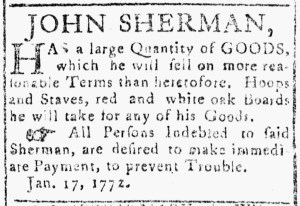What was advertised in a colonial American newspaper 250 years ago today?

“All Persons Indebted to said Sherman, are desired to make immediate Payment, to prevent Trouble.”
John Sherman had two purposes in placing an advertisement in the Connecticut Journal and New-Haven Post-Boy in January 1772. He aimed to attract customers for the “large Quantity of GOODS” available at his shop, but he also wished to collect on debts. As was often the case in colonial newspapers, he pursued both goals in a single advertisement rather than placing multiple notices with distinct purposes. This may have been a strategy to avoid paying for more than one notice, depending on how the printer set advertising rates, but it also suggests that advertisers expected readers to closely examine the content of advertisements as well as news articles, letters, and editorials that appeared elsewhere in newspapers.
In a slightly longer advertisement, Roger Sherman addressed three different purposes. Like John, he marketed textiles and “a general Assortment of other GOODS.” He also demanded that “those indebted to him by Book or Note … make immediate Payment to avoid Trouble.” That threat of legal action echoed the language deployed in John’s advertisement. Finally, he made a much more specific request: “The Person who has his Province Law-Book is desired to return it.” Rather than place a separate advertisement solely about returning the book, he expected that readers would peruse his entire notice.
Such was the case among colonizers who placed advertisements in other newspapers. On the same day that these advertisements ran in the Connecticut Journal and New-Haven Post-Boy, Samuel Noyes, a jeweler, ran a notice in the New-London Gazette. He devoted the vast majority of it to listing items available at his shop, including shoe and knee buckles, rings, and lockets. At the very end, he also announced that he “Wanted a likely Boy as an Apprentice to the Goldsmith’s Business.” Not completely trusting readers to closely examine the conclusion of the advertisement, the compositor used a slightly larger font to draw attention, but that was not usually the case in advertisements with multiple purposes. Neither of the notices in the Connecticut Journal and New-Haven Post-Boy featured variations in font size except for the names of the advertisers (which also served as headlines).
